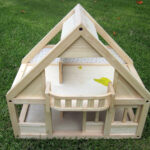Wire a Dollhouse Challenge
Subject: Physics
Grade Level(s): Grade 4
Topic: DC Circuits
Big Idea(s):
- Students know how to design and build simple series and parallel circuits by using components such as wires, batteries, and bulbs.
- Students know electrical energy can be converted to heat, light, and motion.
- Students know how to predict the voltage or current in simple direct current (DC) electric circuits constructed from batteries, wires, resistors, and capacitors.
What you need:
- DC circuit component kit
- Velcro dots
- A doll house
Grouping: Work in Groups of 3
Summary:
In this activity we will use what we have learned about DC circuits to wire a dollhouse.
Learning Goals / Objectives:
Learning Objectives
1.) Students will apply what they have learned about DC circuits to learn how to wire:
- Lights in a house
- An upstairs downstairs switch
- A fan
- Track lighting
- A dimmer switch
Background
This activity is relatively bullet proof. It should probably come after a systematic treatment of DC circuits.
Safety
This activity has little to no risk associated with it. Students may be a little apprehensive, thinking they may get a shock from the battery. They will not be shocked by a D cell or any other 1.5 V battery. Batteries may get warm when in operation.
Anticipatory Set:
Driving Questions
1. What is a circuit? Open? Closed? Short?
2. What does a battery do?
3. What does it mean to have devices: in parallel? in series?
4. How can you utilize electric energy?
5. How can generate electric energy?
Instructions / Activities:
Make sure you have the following:
- DC circuit component kit
- Velcro dots
- A doll house
The Challenge:
Wire my house!
You are a micro-electrical contractor. Your client (me) wants to see the following elements in their new house:
- Lights that turn on and off
- “track lighting” in the kitchen
- A fan (variable speed if possible)
- A light with a “dimmer” switch
- A light with an upstairs downstairs switch
And … at least one of your devices must be powered using a hand-crank generator.
Brain storm and go!
Follow up questions:
1. Diagram all of the circuits in your house.
2. What are the advantages/disadvantages of having multiple devices use the same power supply?
3 . What differences do you expect to see if devices are: in parallel? In series?
Possible Quantitative Alternatives
After house is wired and circuits are diagramed …
- Go through each circuit with a multi meter and quantitatively follow Ohm’s Law.
- With quantitative measurements of each circuit, calculate the power requirements for each circuit and for the whole house.
Assessment:
Teacher’s Discretion
Wrap-up / Closure:
Teacher’s Discretion
These materials are contained in a kit in our Library!


